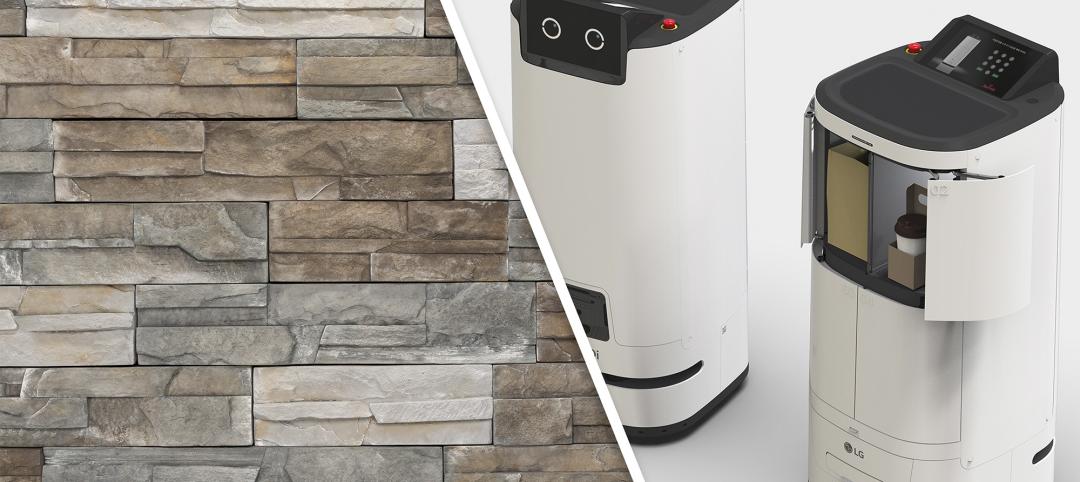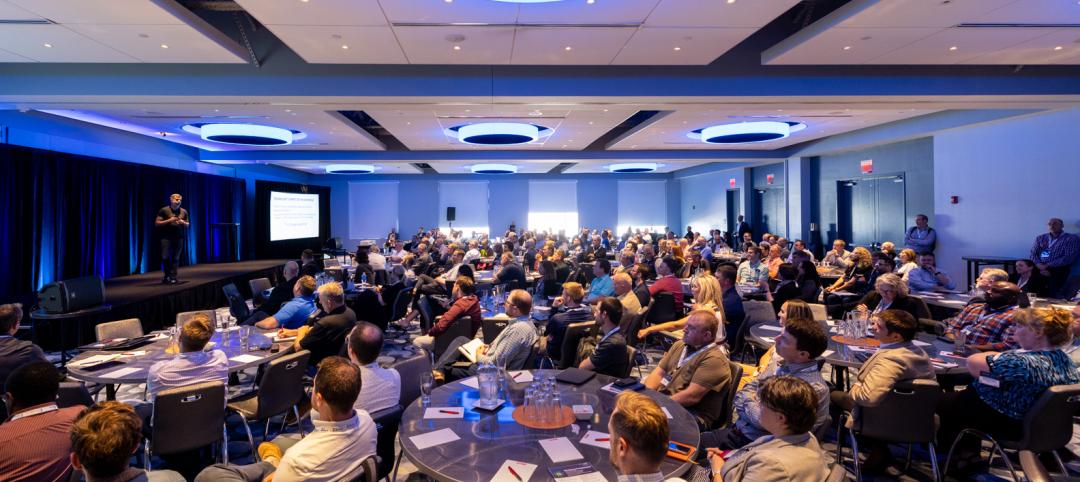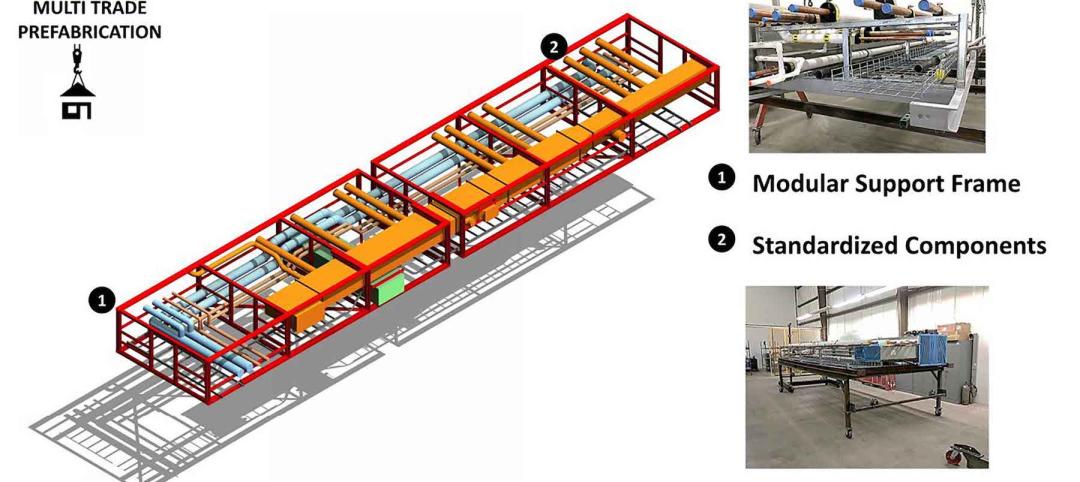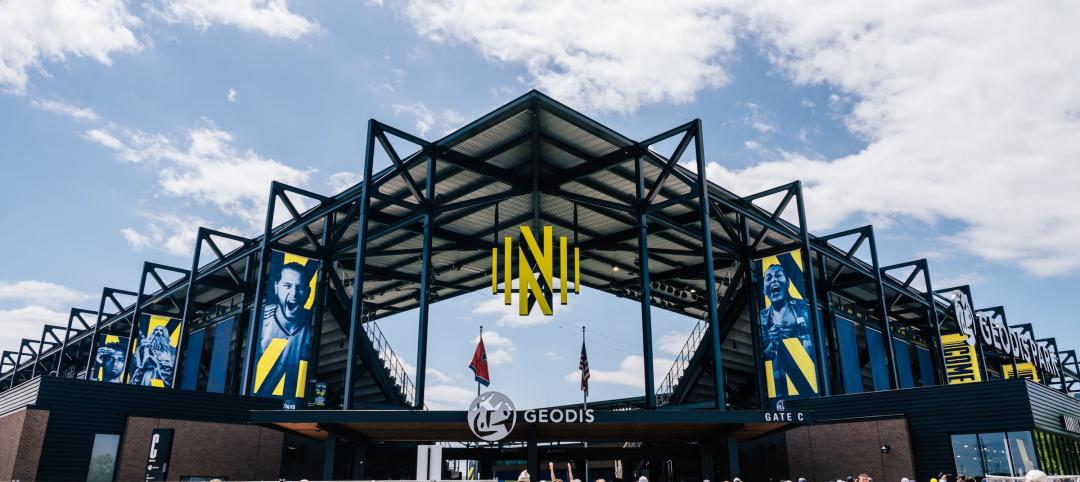Inspired by the city’s mesmerizing network of estuaries and bridges that span the St. Johns River and frame the NFL Jacksonville Jaguars’ home facility, Daily’s Place, the Jaguars’ new 6,000-seat amphitheater and 94,000-sf indoor practice field, owes its identity to a local convenience store chain that won the naming rights.
There was nothing convenient about the amphitheater’s design, however. The 160,000-sf structure is a deceptively complex building, marked by its most intricate feature, an undulating roof. Hundreds of AEC professionals scattered around the world employed a dazzling array of 3D and 4D software programs to create and build this signature design element.
The roof consists of 3,000 tons of structural steel that support a PTFE membrane. The PTFE fabric is suspended from 430-foot-long structural steel trusses that sit atop an array of structural steel v-columns. The roof links the steel beams with the PTFE membrane, which was placed on the underside of the structure—something that had never been done before.
According to Populous, this was done to keep the continuity of the building’s architecture in relation to Jacksonville’s bridges visible from the exterior. Since right angles are rare in nature and just about nonexistent when it comes to rivers, the roof—in fact, the entire structure—was designed such that it does not have a single piece of steel perpendicular to another.

Creating and implementing this riverine design was premeditated, calculated, and engineered to come together exactly the way it did. But without the use of software like Grasshopper, Rhino, and Revit, there is no way the roof could have been completed in five months, as it was.
Grasshopper was used to review the design of the structure and calculate the reductions in roof fabric that were needed to suck in the roof from the sides and reduce overhangs. Grasshopper also helped to rectify a delay in the rolled steel schedule by allowing the team to easily determine which members provided a stronger impact between rolled versus straight members.
The workflow of Rhino to Revit helped the team to discover that the roof geometry needed to be corrected at the intersection of the roof and the concourse. This workflow allowed the build team to locate the intersection early on and correct the geometry before construction advanced too far, saving time and money.
Hundreds of professionals from firms across the U.S. (Kansas City, Los Angeles, New York, and Jacksonville), England, and New Zealand participated in the project. To avoid time-wasting errors, Populous maximized its 3D model and available software to create a model that could be shared by the contractor, steel fabricator, and erector.
Populous and structural engineer and design team member Walter P Moore knew from the outset that “an embedded and nontraditional design and documentation strategy was needed to be able to deliver the complex project in the 12-month construction schedule,” says Thom Chuparkoff, AIA, LEED AP, Lead Project Manager for Populous.

Populous and Walter P Moore implemented, shared, and tested Grasshopper, Dynamo, and Revit concurrently throughout the entire project. This process allowed the design to be automated and iterative to meet the construction managers’ needs and the subcontractors’ schedules.
As the project advanced, the Grasshopper and Revit models were transferred into Tekla software, which allowed for collaboration between the design and construction teams. Populous, Walter P Moore, Hunt Construction Group, Danis Building Construction, Banker Steel, and Structurflex were able to use the same design and fabrication models concurrently to advance the design and detailing for construction.
“Walter P Moore and Populous took responsibility for the Tekla model to create the Advanced Bill of Materials model, which they turned over to Banker Steel for fabrication and assembly,” says Chuparkoff. Banker Steel was then able to use Walter P Moore to utilize their own models for the shop drawing portion. This saved time in fabrication and installation.
In the construction realm, the workflows allowed the design and construction process to become blurred. “By implementing Rhino to Revit early between the architect and structural engineer, we were able to continue that model relationship and extend the workflow into the steel fabrication and detailing,” says Chuparkoff.
Despite the sheer complexity of the structure, the RFI log amounted to less than 300 project-related questions from the field, he says. The multitude of software programs used managed to keep the project organized, updated, and distributed among all team members, regardless of where in the world they were located.
Daily’s Place held its first event May 27. Hometown band Tedeschi Trucks played the first concert in the new amphitheater, which Jaguars owner Shadhid Khan described as “iconic.”
 Grasshopper for Rhino was used with the Lunchbox plug-in to create Daily’s Place’s roof structure.
Grasshopper for Rhino was used with the Lunchbox plug-in to create Daily’s Place’s roof structure.
Software helps demystify the project’s complexity
Here’s how the software programs used in Daily’s Place helped simplify the intricate project:
Rhino and Revit were used as the primary geometry modeling programs for the project. The roof and skin were modeled in Rhino, which is considered more dynamic for complex geometry. Rhino was also the common medium for collating digital models and coordinating between teams for interfacing and clash detection of fabric and steel. It was also used for studies of ponding and drainage of the fabric surface. Revit was used for all other geometries and full construction documents.
Grasshopper for Rhino was used in tandem with the Lunchbox plug-in to build the roof surface and subdivide the structure into trusses. The roof form was designed by Populous; then the Grasshopper script was worked on jointly with Walter P Moore to create the structure for the roof.
A Grasshopper script was used to write out point data to an Excel file to transfer geometry from Rhino to Revit for coordination and documentation. Then Dynamo was used to pull that data into Revit to build native geometry with adaptive components. As Walter P Moore was engineering the structure, Populous used this workflow to represent the structure in the Revit model and drawings.
Kangaroo, a form-finding plug-in for Rhino-Grasshopper, was used in the early stages of the job to quickly study design intent. The structure could be updated as programmatic and functional directives changed the roof form. The base input for the script was 13 input curves that could be manually adjusted in Rhino.
The structural analysis components of GSA and SAP software were used in tandem to study structural steel and fabric. These programs helped analyze the structural steel framing through custom-developed plug-ins developed by Walter P Moore that used Grasshopper as the primary interface.
Tekla was used to communicate the full steel package and connection details with the steel contractor via the 3D model. This enabled the seamless transition from CDs to shop drawings and fabrication.

 Each piece of steel was modeled and placed with purpose in order to create a design that resembled Jacksonville’s numerous bridges and estuaries. The result is a building without a single piece of steel perpendicular to another.
Each piece of steel was modeled and placed with purpose in order to create a design that resembled Jacksonville’s numerous bridges and estuaries. The result is a building without a single piece of steel perpendicular to another.
Related Stories
Airports | Aug 22, 2024
Portland opens $2 billion mass timber expansion and renovation to its international airport
This month, the Portland International Airport (PDX) main terminal expansion opened to passengers. Designed by ZGF for the Port of Portland, the 1 million-sf project doubles the capacity of PDX and enables the airport to welcome 35 million passengers per year by 2045.
AEC Tech | Aug 19, 2024
Harnessing AI to revolutionize architectural design and creativity
Architects are wondering if AI will replace us. For Vessel, the gains offset the fear. We believe there is wisdom in the unattributed quote, “You won’t lose your job to AI. You will lose your job to someone using AI.”
Energy Efficiency | Aug 9, 2024
Artificial intelligence could help reduce energy consumption by as much as 40% by 2050
Artificial intelligence could help U.S. buildings to significantly reduce energy consumption and carbon emissions, according to a paper by researchers at the Lawrence Berkeley National Laboratory.
Products and Materials | Jul 31, 2024
Top building products for July 2024
BD+C Editors break down July's top 15 building products, from Façades by Design to Schweiss Doors's Strap Latch bifold door.
Smart Buildings | Jul 25, 2024
A Swiss startup devises an intelligent photovoltaic façade that tracks and moves with the sun
Zurich Soft Robotics says Solskin can reduce building energy consumption by up to 80% while producing up to 40% more electricity than comparable façade systems.
Great Solutions | Jul 23, 2024
41 Great Solutions for architects, engineers, and contractors
AI ChatBots, ambient computing, floating MRIs, low-carbon cement, sunshine on demand, next-generation top-down construction. These and 35 other innovations make up our 2024 Great Solutions Report, which highlights fresh ideas and innovations from leading architecture, engineering, and construction firms.
AEC Tech Innovation | Jul 4, 2024
Caution competes with inevitability at conference exploring artificial intelligence for design and construction
Hosted by PSMJ, AEC Innovate in Boston found an AEC industry anxiously at the threshold of change.
Contractors | Jun 4, 2024
Contractors expect to spend more time on prefabrication, according to FMI study
Get ready for a surge in prefabrication activity by contractors. FMI, the consulting and investment banking firm, recently polled contractors about how much time they were spending, in craft labor hours, on prefabrication for construction projects. More than 250 contractors participated in the survey, and the average response to that question was 18%. More revealing, however, was the participants’ anticipation that craft hours dedicated to prefab would essentially double, to 34%, within the next five years.
AEC Tech | Apr 30, 2024
Lack of organizational readiness is biggest hurdle to artificial intelligence adoption
Managers of companies in the industrial sector, including construction, have bought the hype of artificial intelligence (AI) as a transformative technology, but their organizations are not ready to realize its promise, according to research from IFS, a global cloud enterprise software company. An IFS survey of 1,700 senior decision-makers found that 84% of executives anticipate massive organizational benefits from AI.
BIM and Information Technology | Mar 11, 2024
BIM at LOD400: Why Level of Development 400 matters for design and virtual construction
As construction projects grow more complex, producing a building information model at Level of Development 400 (LOD400) can accelerate schedules, increase savings, and reduce risk, writes Stephen E. Blumenbaum, PE, SE, Walter P Moore's Director of Construction Engineering.

















